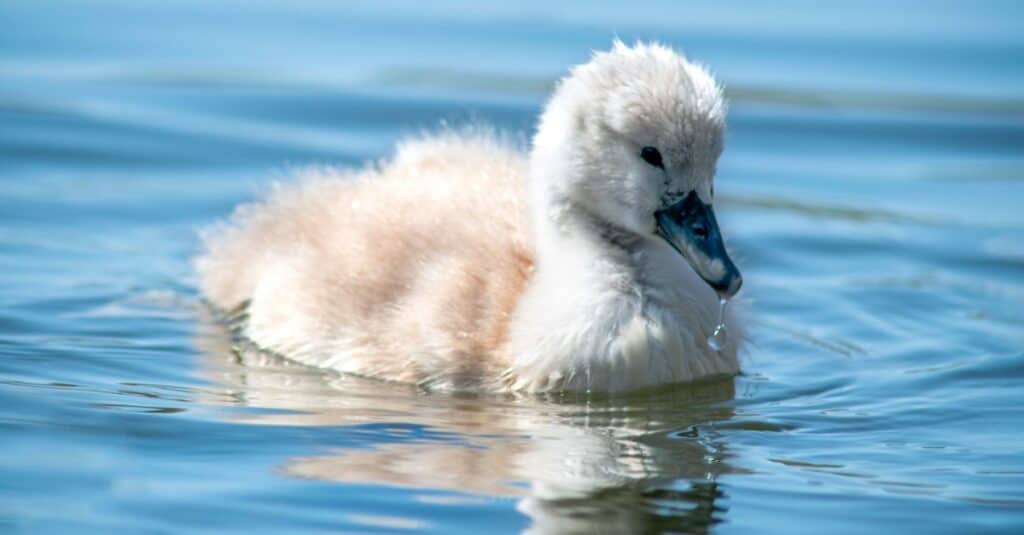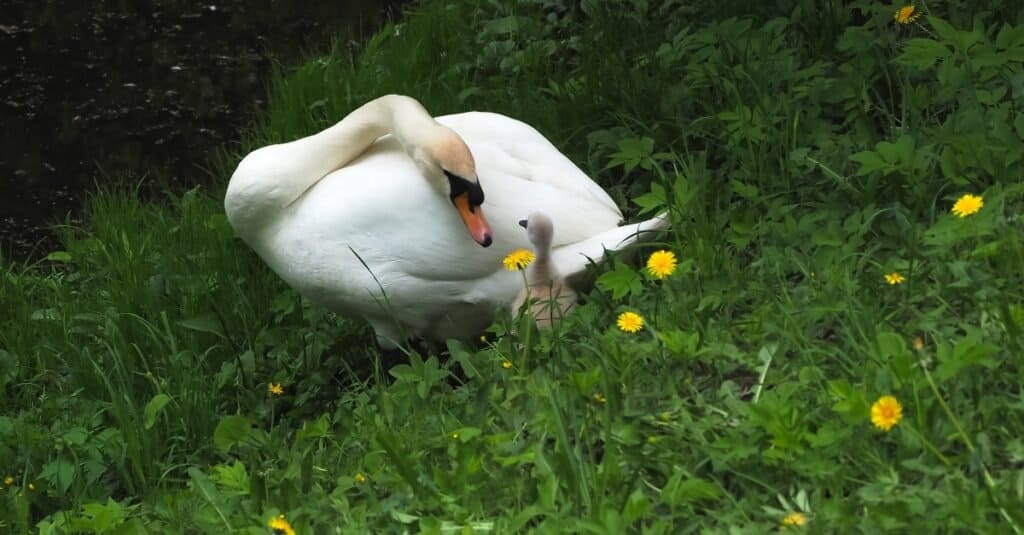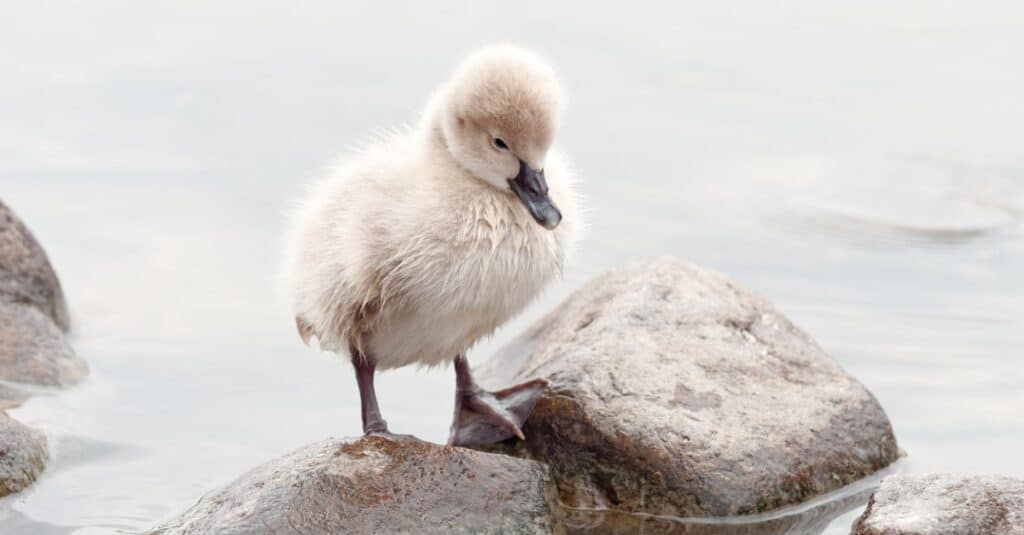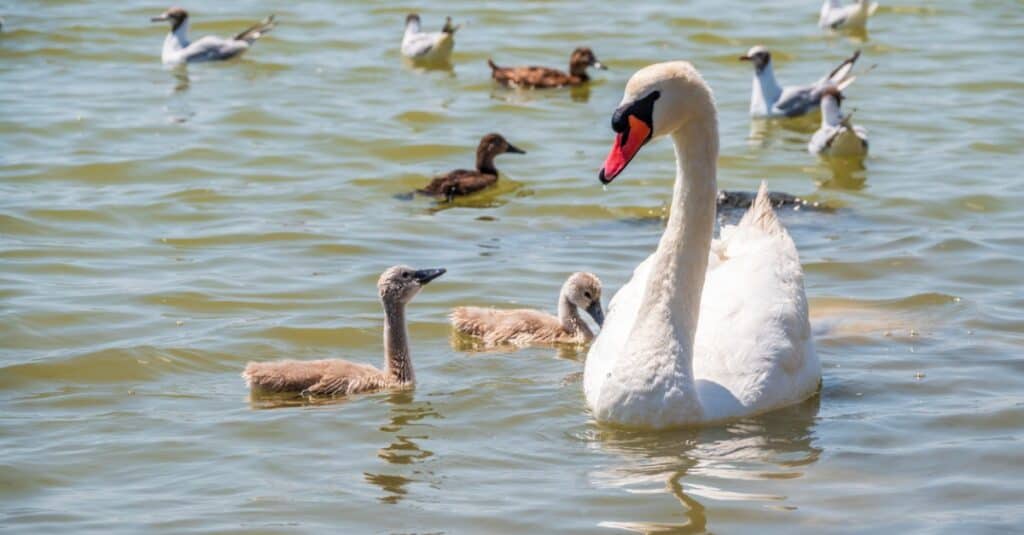Are you curious what a baby swan is called? Did you know they are extremely large babies? Swans are known to be beautiful and quite graceful creatures but there are many other facts about them that you may not know.
Let’s dive right in and discover five amazing facts about baby swans!
#1: A Baby Swan is Called a Cygnet!

Young swans are called cygnets.
©iStock.com/Freila
When swans are born they’re called cygnets, which is pronounced sig-net. Cygnets keep their name until they’re a year old at which time they have two options for names. An adult male swan is called a cob and an adult female swan is called a pen.
While there is no specific term for a group of baby swans, a group of swans is called a flock.
#2: Baby Swans Have Dedicated Parents

Swan parents are very involved in the lives of their babies.
©iStock.com/Lemanieh
While it’s no secret that swans mate for life, there are a few common misconceptions about them. For example, if one swan in the relationship passes away, the remaining swan will usually find another mate. The same is true if a pair of swans have been unsuccessful in making babies. It’s often thought that they will remain alone if these things occur but that’s usually not true.
Mating isn’t the only thing that swans work together on for the sake of their babies. The female swan incubates the eggs while the male swan swims outside to protect the new mother and her unhatched babies.
At about a year old, the cygnets will be alone in the nest and be responsible for joining a new flock. Most swans stay with the flock they’ve chosen for their whole lives.
#3: Swans Can Swim Hours After Hatching

Swan cygnets take their first swim just hours after birth.
©iStock.com/Stanislav Sablin
After a swan hatches, it wastes no time getting out on the water. It might be hard to believe that such a freshly born baby can already learn how to swim, but it’s true! At just a few hours old, swan cygnets are strong enough and have the instincts needed to start swimming.
The cygnet’s first trip to the water is mostly a test run, supervised by the mother swan. However, sometimes, swan cygnets get their first taste of small bugs and other snacks at the water’s edge. These are all vital skills that the tiny birds need to learn so that they can survive on their own in the wild.
#4: Baby Swans are Large Babies

Swans have larger babies than
ducks
.
©iStock.com/yanjf
There’s no doubt that baby ducks and swans have many similarities. However, when it comes to their size at birth, they couldn’t be more different.
When a newborn duck hatches, it only weighs about 50 grams. On the other hand, when a swan cygnet hatches, it weighs a staggering 200 to 250 grams! Ducks weigh about 2 to 3 kilograms as adults, while swans weigh around 14 kilograms!
By far the largest swan baby is the baby Trumpeter Swan. Not only are they quite large in comparison to other birds, but Trumpeter Swans are also the among the largest flying birds. It’s no wonder, considering that their wingspan can reach up to eight feet.
#5: Swan Cygnets Imprint

Swan cygnets imprint on the first thing they see, whether that be their mother or an airplane!
©iStock.com/Dmitry Potashkin
Imprinting is when the babies program themselves to listen to their mother’s every word and follow her around endlessly. For a baby swan, this means that the first large moving things these babies come into contact with will be the thing the cygnets follow for the first 6 months of life. This is why they are often seen following their mother around and depending on her for everything.
When Do Cygnets Turn White?
Cygnets will have a soft, fluffy grayish coat when they hatch, with black beaks and black feet. As they grow, their feathers turn somewhat brown for six months. By age one, they become whiter but will have a gray feather here and there for another year.
The beak of the juvenile swan turns from black to a grey-pink. Being fully white with an orange beak happens with maturity (Trumpeter swans maintain a black bill). The frontal knob of the bill doesn’t show until maturity either, after three or four years, even though they achieve their adult size around two years of age.
Thank you for reading! Have some feedback for us? Contact the AZ Animals editorial team.








